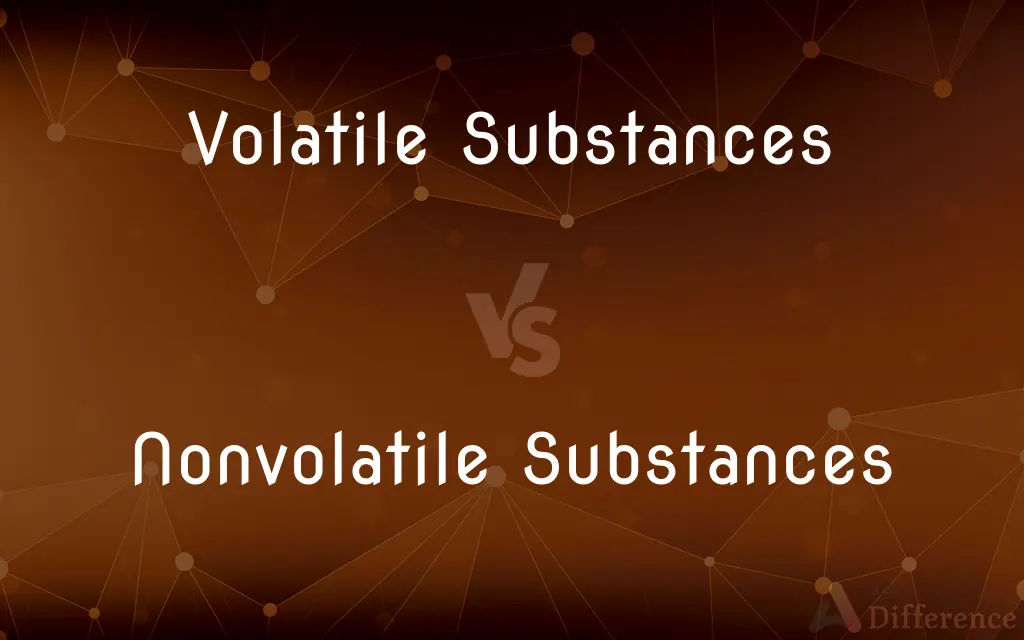Volatile Substances vs. Nonvolatile Substances — What's the Difference?
Edited by Tayyaba Rehman — By Fiza Rafique — Published on December 6, 2023
Volatile Substances easily vaporize at normal temperatures, while Nonvolatile Substances resist vaporization. Both determine the evaporation and boiling properties of materials.

Difference Between Volatile Substances and Nonvolatile Substances
Table of Contents
ADVERTISEMENT
Key Differences
Volatile Substances and Nonvolatile Substances are terms primarily used in chemistry to describe a substance's tendency to vaporize. Volatile Substances have a high vapor pressure at ordinary temperatures, meaning they can readily evaporate or transform from a liquid or solid state into vapor. Nonvolatile Substances, on the contrary, have a much lower vapor pressure and do not readily evaporate.
The presence of Volatile Substances often dictates the scent or aroma of many products. For instance, perfumes contain Volatile Substances that quickly evaporate, releasing the fragrance. Nonvolatile Substances, however, contribute more to the structure or base of a product, staying intact for longer durations and not contributing to the aroma.
The boiling point is a significant distinction between Volatile Substances and Nonvolatile Substances. Volatile Substances generally have lower boiling points, making them transition to the gaseous phase more rapidly. Nonvolatile Substances possess higher boiling points, indicating their resistance to becoming vapor.
In solutions, Volatile Substances can significantly affect properties like vapor pressure. When a solution contains a Volatile Substance, its vapor pressure will be notably higher than a solution with only Nonvolatile Substances. This distinction is vital in processes like distillation.
Both Volatile and Nonvolatile Substances play crucial roles in various industries. While Volatile Substances are essential for products needing quick evaporation, Nonvolatile Substances provide stability and long-lasting properties to items like paints and coatings.
ADVERTISEMENT
Comparison Chart
Vapor Pressure
High vapor pressure at ordinary temperatures.
Low vapor pressure at ordinary temperatures.
Boiling Point
Generally lower boiling points.
Typically higher boiling points.
Presence in Solutions
Increases vapor pressure of solutions.
Does not significantly affect vapor pressure.
Aroma Contribution
Contribute to scent or aroma.
Typically do not contribute to aroma.
Usage in Industries
Essential for quick evaporation.
Provide stability in products.
Compare with Definitions
Volatile Substances
Elements transitioning quickly from liquid to gas.
Perfumes utilize Volatile Substances to release their fragrances.
Nonvolatile Substances
Materials that do not evaporate quickly.
Many thick creams contain Nonvolatile Substances to ensure longevity.
Volatile Substances
Compounds with high vapor pressure at room temperature.
Alcohol is one of the Volatile Substances in wine that contributes to its aroma.
Nonvolatile Substances
Compounds with low vapor pressure at room temperature.
Salt, a Nonvolatile Substance, does not readily vaporize.
Volatile Substances
Materials prone to rapid evaporation.
Volatile Substances in nail polish help it dry quickly.
Nonvolatile Substances
Chemicals resistant to vaporization.
Oils are typically Nonvolatile Substances, not evaporating quickly.
Volatile Substances
Chemicals that vaporize easily.
Gasoline contains numerous Volatile Substances, making it highly flammable.
Nonvolatile Substances
Elements that remain stable in liquid or solid form.
In cooking, sugar acts as a Nonvolatile Substance, not evaporating easily.
Volatile Substances
Substances that readily become vapor.
Many solvents are Volatile Substances, cautioning against their inhalation.
Nonvolatile Substances
Substances that resist transitioning to vapor.
Waxes, as Nonvolatile Substances, stay solid at room temperatures.
Common Curiosities
What causes Volatile Substances to evaporate quickly?
Their high vapor pressure at ordinary temperatures.
Can a solution contain both Volatile and Nonvolatile Substances?
Yes, many solutions can contain a mixture of both.
Why do Volatile Substances have lower boiling points?
Their molecular structure allows them to transition to gas more easily.
How does vapor pressure relate to Volatile and Nonvolatile Substances?
Volatile Substances have high vapor pressure, while Nonvolatile Substances have low.
Why don't Nonvolatile Substances evaporate easily?
Their molecular structure makes them stable, resisting the transition to vapor.
Do Nonvolatile Substances contribute to the aroma of products?
Typically, they do not, as they resist vaporization.
Would sugar be considered a Volatile or Nonvolatile Substance?
Sugar is a Nonvolatile Substance as it doesn't readily evaporate.
Are Nonvolatile Substances found in perfumes?
While the scent primarily comes from Volatile Substances, Nonvolatile Substances might be used as stabilizers or carriers.
How do Volatile Substances affect the vapor pressure of a solution?
They increase the vapor pressure due to their tendency to vaporize.
Do Volatile Substances always have an odor?
Not always, but many do due to their rapid evaporation.
Why are Nonvolatile Substances often used in paints?
Their resistance to vaporization offers stability and long-lasting properties.
What's a common example of a Volatile Substance?
Ethanol is a common Volatile Substance found in alcoholic beverages.
Can changes in temperature affect the volatility of a substance?
Yes, increasing temperature can make some Nonvolatile Substances act more volatile.
Are all liquids Volatile Substances?
No, only those liquids that vaporize easily at ordinary temperatures are considered volatile.
How do industries utilize the properties of Volatile Substances?
They are often used in products needing rapid evaporation, like perfumes or solvents.
Share Your Discovery

Previous Comparison
Existentialist vs. Nihilist
Next Comparison
1080p vs. 720pAuthor Spotlight
Written by
Fiza RafiqueFiza Rafique is a skilled content writer at AskDifference.com, where she meticulously refines and enhances written pieces. Drawing from her vast editorial expertise, Fiza ensures clarity, accuracy, and precision in every article. Passionate about language, she continually seeks to elevate the quality of content for readers worldwide.
Edited by
Tayyaba RehmanTayyaba Rehman is a distinguished writer, currently serving as a primary contributor to askdifference.com. As a researcher in semantics and etymology, Tayyaba's passion for the complexity of languages and their distinctions has found a perfect home on the platform. Tayyaba delves into the intricacies of language, distinguishing between commonly confused words and phrases, thereby providing clarity for readers worldwide.












































